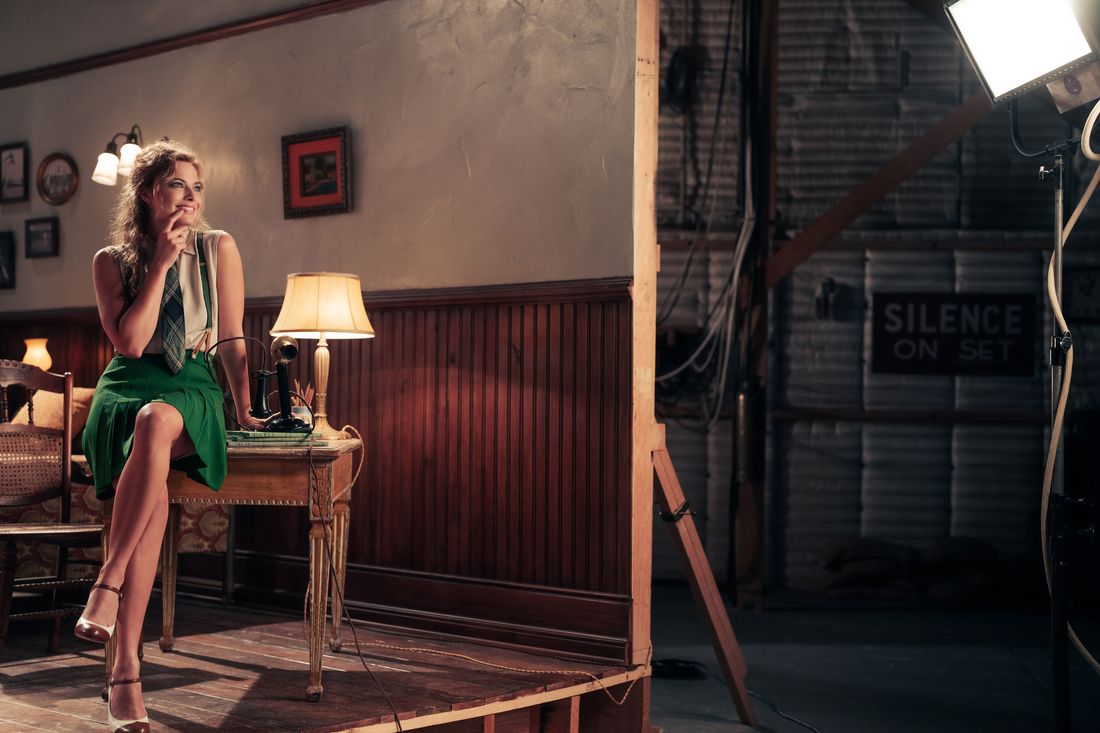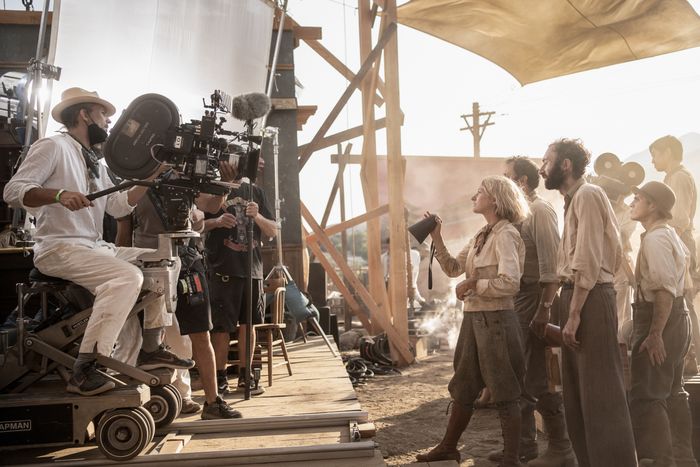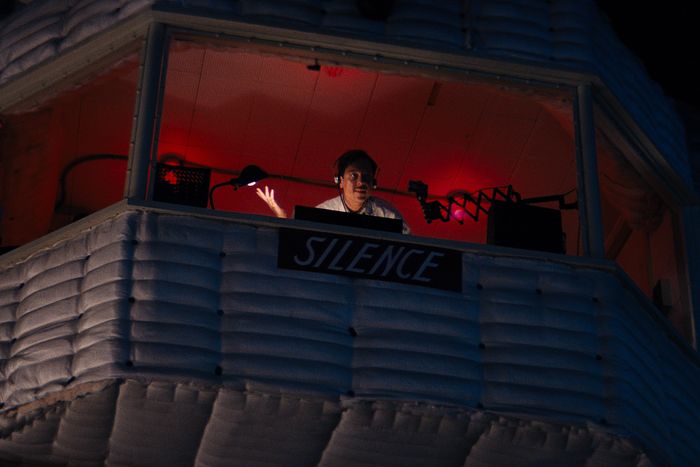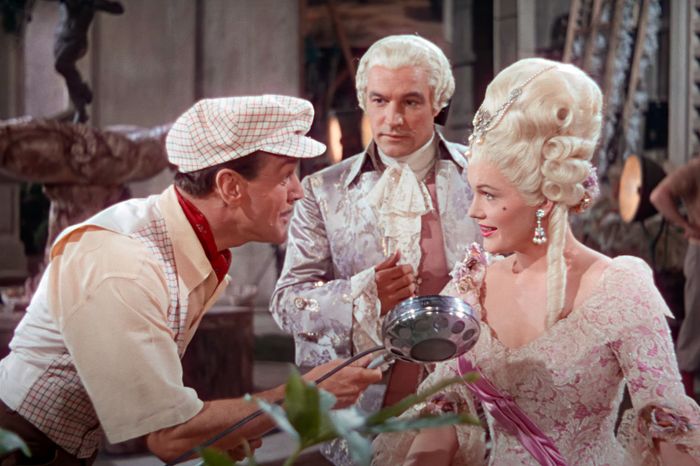
Damien Chazelle’s Babylon opens with an elephant unleashing a powerful stream of diarrhea on a person, and then moves onto a deranged, drug-fueled Hollywood fête where a woman pees on an ecstatic man while calling him “Piggy.” And yet, the most notable sequences in this film of endless animalistic urges, unchecked hedonism, and out-of-control bodily functions involve Tinseltown party animals getting down to business and making movies. Set in the 1920s and ’30s, Chazelle’s epic depicts the highly volatile period when the freewheeling silent era transitioned to sound, which also happened to be right around the time the industry became more regimented, moralistic, and unforgiving.
Chazelle mostly ignores realism and historical authenticity in favor of a dreamlike, purposefully anachronistic portrait of how the movies and the people who made them changed during this period. At the heart of this portrayal are three major sequences: One is a chaotic and freewheeling look at silent-film productions; the second is a nerve-racking set piece that shows one of our heroes, Nellie LaRoy (Margot Robbie) attempting to shoot her first sound scene; the final sequence involves our other lead, Manny Torres (Diego Calva), watching a delirious closing montage through film history that begins with Singin’ in the Rain and jumps back and forth across the past century-plus of movies — a sequence that Chazelle himself admits wound up being the most controversial in the picture.
Scene One: How to Make a Silent Movie
Babylon’s introduction to silent-era moviemaking is a sequence that intercuts between two productions. One is a cheap feature being shot by director Ruth Adler (Olivia Hamilton) on a makeshift set where multiple Kinoscope Pictures films are being made simultaneously. It is during this production that Nellie LaRoy is discovered. Meanwhile, legendary leading man Jack Conrad (Brad Pitt) is starring in another, bigger-budget production — a romantic war epic that is being filmed with a cast of thousands — directed by the high-strung German auteur Otto Van Strassberger (Spike Jonze).
Damien Chazelle (writer-director): Pretty much all of that was our first two weeks of shooting. I’m a believer in trying to start with something hard. If you don’t die those first couple weeks, you feel like the wind is behind your sail a little bit — like you can do anything. We had about five days on the Margot set, five days on the battlefield. It was a race to the finish — a shooting pace that I hadn’t experienced since Whiplash.
Tom Cross (editor): The goal was to really present the Wild West days of Hollywood. So make it loud, reckless, revel in how feral that is.
Linus Sandgren (cinematographer): The Wild West of the silent era is all about movement and joyous exploration of the chaos in how they were shooting things, with orchestras and small bands playing everywhere. They were shooting outside in really hot exteriors. They built the stages outside and just covered them with some silks in order to control the light. We wanted to embrace that hot-desert look.
Chazelle: Linus talked about trying to push the extremes of contrasts in the film’s style. So we overexposed more than you normally would outside, but then we’re at the very limits of underexposure with some of the darker scenes. Outside, you feel the sun attacking you, and the sky goes white. Then for the interiors, we have these really rich, inky blacks, where a lot of the frame just goes into chiaroscuro.
Sandgren: It was really about not making a polished film, but an expressive impressionistic view of this world. So we pushed the limits of what we normally would do in those situations in order to make it more expressive. It’s very satisfying to feel like you every day capture the film the way you intend to and not wait for later to fix things.
Cross: We also talked about leaning into the cutting style that you might have in the silent era. Movies like D.W. Griffith’s Intolerance loomed very large. And certainly on the battlefield with the crash cutting and these colliding images, we leaned into Sergei Eisenstein.
Chazelle: We were trying to adopt those silent-era techniques, but we were also very conscious of never wanting it to feel like we were imitating a silent film. What actually interested us was trying to collide those very timeless techniques with things that you could only see in a modern movie. Whether that’s some of the gross-out humor, or the level of drug use, or sexuality. Certainly there’s a cocaine-ish type of speed to the cutting in here that is not something you would normally see in the silent era, not even in Eisenstein.
But it’s easy to forget just how much everything we do today, or that we’ve thought of as innovations in film techniques, were visible in ’20s films. After sound came in, you could argue it took another ten years or more for Hollywood to relearn how to be free, how to move the camera the same way. Some people would argue it took all the way until Orson Welles showed up before Hollywood managed to reapproximate the suppleness and fluidity and expressiveness and experimentation of those late silent years. There’s nothing in Citizen Kane that didn’t exist at some stage in a silent film before. All of Citizen Kane comes from Murnau, and Griffith, and Stroheim, and Lang and Expressionism.
Scene Two: Let There Be Sound
Once Hollywood switches to sound filmmaking, we see Nellie LaRoy, now a star, appear in her first sound picture, again directed by Ruth Adler. But this time, the energy and invention of the previous scene is nowhere to be found. Instead, the production spends an absurd amount of time trying to get one shot successfully into the can. Everything goes wrong: Nellie misses her mark. She speaks too loudly. She speaks too softly. Someone’s watch is too loud. A metal pin in Ruth’s leg makes a hissing sound. Someone opens the door to the soundstage. The first assistant director (P.J. Byrne) loses his mind. Finally, the cameraman, stuck inside a tiny booth designed to mute the sound of the camera, dies of heatstroke.
Chazelle: The closest real-life inspiration for Ruth Adler was probably Dorothy Arzner, who famously collaborated with Clara Bow. I’d also say a little bit of Lois Weber. Alice Guy-Blaché is a little earlier in the silent era, but that sort of domineering personality. Dorothy Davenport is another one, someone who was a little outside the main studio system.
Kinoscope is a fictional studio, but it’s the scrappier counterpart to MGM, so maybe it’s a little like Columbia. Not quite Poverty Row, but they definitely don’t have the budgets that Jack Conrad has. They’re not shooting thousand-person battlefield scenes with an Erich von Stroheim type. They’re doing six movies at once on one bare-bones studio lot. Someone like Ruth is probably shooting a movie a week.
For Ruth, I liked this idea of someone who can barely sit still, who’s always moving. The first time we ever see her, she’s literally manhandling a guy who’s five times her size, pushing one of the extras into the bar, screaming her head off. Then, by the last time you see her, she’s literally told that she can’t even move her leg because she’s got a spring in it. When sound comes in, the Ruths of the world get weeded out.
Cross: In the first section of the film, we take these different story threads and braid them together, and that creates a momentum. That style will crescendo to something very chaotic and insane. By the time Manny goes to see The Jazz Singer and we reach that final downbeat, you want to be able to reset. That was always intended: At this turning point when we introduce sound, we’re going to completely reset the style.
Something that was an amazing learning experience for me on Whiplash was when we talked about the power of repetition. Often, as editors, you’re trying to change the coverage, change the shot sizes, change the rhythm to keep it fresh for the audience. You don’t want the audience to get bored, so you’re constantly doing little parlor tricks to pull them in. But in this scene, we went in the opposite direction. We went for the repetition to make the audience uncomfortable. They’re going to start wondering, How long is Nellie going to be doing this?
Chazelle: I love this idea where a scene can metastasize in front of your eyes to something very, very different and outside of the norm, just by dint of repetition and protraction. It’s that Hitchcock thing where if you keep the two people seated at the table with the bomb ticking underneath, you do that for 30 seconds, it’s one thing. But if you just stretch that like a wire, you feel that wire stretching and stretching and stretching, and that makes you all the more anxious for it to snap. Sometimes, to do a suspense sequence properly, you have to commit to going all the way, even if it feels uncomfortable at certain times. You have to embrace the discomfort.
Cross: So we created a little preamble for the beginning of every take. Damien and Linus shot these amazing details: the red light turning on with the buzzer going off, the slate boy running in, Ruth cuing with her hand, cuing action, and the shot of the door opening, and Nellie’s feet, and the suitcase. Every time we go back to it, we cut a little bit faster, which we can do because we’ve created this shorthand. You’re on this mechanical march toward a not-so-good outcome. This whole sequence was one of the most fun scenes that I had cutting, but also one of the hardest, because the challenge is similar to Whiplash. How do you make band practice feel like a war movie? In the case of Babylon, it’s how do you make the sound of a pin drop or a guy sneezing feel like life and death?
Chazelle: We wanted to create a sense of rhythm and musicality without any music. It’s one of the few scenes that has zero music at all. And yet I think it’s a very musical sequence. And Nellie’s “Hello, college!” breaks through like nails on a chalkboard. Margot worked for months on testing out different accents and different types of speaking and pitches and intonations and levels of scratchiness. Once you get to the end of the movie, you’re reminded of Lina Lamont and Jean Hagen’s performance in Singin’ in the Rain. But I didn’t want three hours of a Lina Lamont imitation. Hopefully the audience feels a little worry for her as a sound actress, while still thinking there’s a chance. To keep that hope alive was key for the suspense — that from the beginning of the scene, you think maybe they will pull this off. But we had a rule: that there couldn’t be any normal scenes in this movie.
III. Scene Three: The Final Montage
In what is probably the most controversial (and spectacular) scene in Babylon, Manny Torres, now a middle-age man with a family, returns to Hollywood and finds himself seated in a theater watching Singin’ in the Rain. As Stanley Donen and Gene Kelly’s 1952 classic about the coming of sound to Hollywood unfolds, Manny finds himself tearing up as he recalls how he and Nellie (now long dead) once faced the same challenges, and he’s shocked at the people around him in the theater laughing at these scenes. But then, in what starts to feel like cinema history’s version of the Stargate sequence from 2001: A Space Odyssey, the images on the screen change to shots from Babylon and from many other films — reaching even beyond 1952 and through the 1960s and ’70s and into the present day, including images from Avatar (2009). As Chazelle notes, this sequence was originally supposed to feature Manny watching just Singin’ in the Rain. Late in postproduction, the filmmakers realized that they had to change things dramatically.
Chazelle: It was after we’d finished most of the movie, and Tom and I had a little bit of a come-to-Jesus moment. We looked at each other — along with some of the producers — and we realized that we had all, independently, gotten a feeling deep in the pit of our stomachs: The movie hadn’t found an ending. Because of the style that we had established with the movie — as this three-hour, sensory overload, balls-to-the-wall kind of epic — the more normal movie language of just training the camera on an actor and recording a moment in time, and having that be the end of the movie, was just not enough. It felt anticlimactic. Our big realization was that it’s a movie of set pieces, and it needs to end with a set piece. So we thought, “Okay, what are things we can do editorially, that the script gestured to, that we just haven’t explored?”
Cross: It had to be something that was coming from Manny emotionally, but it was something that the audience needed to experience.
Chazelle: So we told the studio it’s going to be another few weeks before we could finish the movie. Tom and I just went to work, and it was almost like improv sessions. We just started free-forming it, knowing we didn’t want to shoot anything new.
Cross: There was a balance that we played around with. The balance had to do with Manny’s memories, and also the audience’s memories of this time in Hollywood. Part of it was harkening back to the beginning — to the spirit that we introduced in that first party. But then it was also about this vision of the future.
Chazelle: When I’m asked, “Why did you pick this clip or that clip?” or whatever, the only real thing that’s not just gut instinct that I can summon up was that in our minds, we were trying to somehow convey this idea of a life cycle, of growing up, dying, and then rebirth. Death and rebirth, death and rebirth.
Sandgren: What’s beautiful about that sequence to me is that you connect Manny sitting in the theater back then to me, through this tunnel of images. It’s a time capsule between him and me in the modern day. And that’s overwhelming and enlightening. That’s the meaning of cinema. It’s really the meaning of life. It is explained, but not in a too intellectual way. It’s more in an emotional way.
Cross: I remember when we were putting it together, it was vulnerable to people wanting to apply logic to it. “I don’t recognize these movies. It needs to be this specific movie and this is the milestone that I remember and it’s got to be this.” This sequence was very vulnerable to that type of logic. And Damien and I, we really try to not think of it so literally. We tried to think of it more graphically.
Chazelle: If we let logic invade it too much, it would destroy it. We had a few people who were very supportive of the idea, but then more people started seeing it, before the movie was finished. And, in a movie of elephants and diarrhea splattering the cameras and pogo sticks spraying semen, it became the most controversial thing by far! This idea of going into the future, going past 1952, people had a very hard time dealing with that. People were going, “You’ve destroyed the movie! You had a good movie and you’ve just kamikazed it!” The only justification I could use when I would try to argue it would be, “But that’s the whole point of the movie! That’s what makes it the ending to Babylon. This has to be a movie that always feels on the verge of kamikazing itself.” This would not be the appropriate ending for a different kind of movie. But for this movie, it’s not only the appropriate ending, I would argue it’s the only ending.
More From This Series
- The Stories Behind Severance’s Eerie Office Design
- ‘Here’s This School, and We’ve Just Introduced 5 Sociopaths’
- That Babygirl Milk Scene Wasn’t Totally Fiction





